Renault Captur

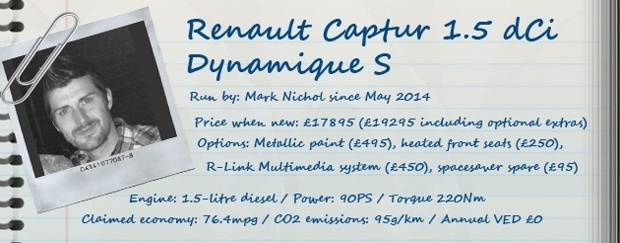
- Non-Modus operandi
- Like pushing a metal detector through the Royal Mint
- A design for life?
- Driven mad, at exactly 50mph.
- No maps found!
- Renault maps found!
- Eco sorrier
- Progress is too leisurely
- Deep heat
- I am (sort of) your father
- The Renault Modus was 'somewhat unattractive'
- This morning I lost another HGV
Non-Modus operandi
Our newest contributor Mark takes delivery of our newest arrival, the Renault Captur. But is it really just a new Modus?
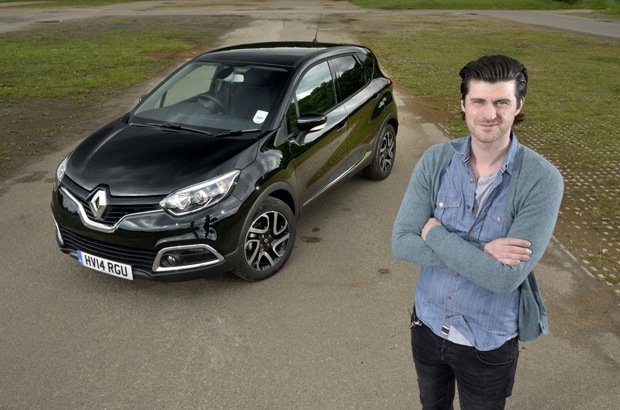
Date: 6 June 2014 | Current mileage: 2800 | Claimed economy: 76.4mpg | Actual economy: 51.5mpg
Back when I was a skint student, as opposed to a skint grown-up, I bought a Renault Megane. I bought it because we had a baby on the way and my Clio Extreme was neither big nor especially extreme. I also liked how the Megane was famous primarily for its billboard-happy behind. The Renault Megane was twerking a decade before Miley Cyrus was.
I don’t recall much about the ownership experience (which is high praise, I suppose, by virtue of it being a second-hand French hatchback), but I do remember a detail about the first visit to the dealership. While pacing the used forecourt, wearing my best ‘please do not disturb me, salesman’ face, I was disturbed by one.
Nothing unusual there, but what he did next was. During a conversation about my budget, he pointed at a particular car and dismissively suggested that, despite it being well within reach financially, it wasn’t for me. Then he laughed. His honesty was surprising enough to make this my only resounding memory of the whole experience, because he wasn’t pointing at a rival car, as you might expect. He was pointing at a Renault Modus.
I bring this up because the car I now find myself running is, really, a Modus. It’s based on the Clio but made taller to carry four-and-a-half people more comfortably. It caters to the ‘budget’ (read: young) end of the buyer demographic with regards price, build and running costs - it takes its styling blueprint from a naturally bigger type of car, then shrinks it down.
But it’s the last of those things that’s also the key differentiator, because when maximising the Clio this time around, Renault chose to miniaturise not an MPV, but an SUV. I wonder why? I mean, Renault practically invented the MPV market with the first Espace (some beg to differ, I know), and continues to be synonymous with the format. And its last SUV-type car, the Koleos, was so staggeringly average that nobody remembered it existed, nor was bothered when Renault quietly withdrew it from sale after only a couple of years. Those things in mind, the Renault Captur looks a strange decision.
Apparently not. “The supermini crossover class is the fastest-growing in UK and across Europe currently. In the UK, sales of the top B-segment SUV are currently just short of double what they were same period in 2013…Captur is rapidly hunting (the Nissan Juke) down, (with) over 7,000 sales year-to-date and second in the class,” a Renault PR person told me.
New Captur. Definitely not a Modus.
Meanwhile, over in Spain, ENJOYNEERING a new crossover-SUV thingy by mashing a SEAT Leon onto a Skoda Yeti is a bit of an obsession – both at management level and in the dealer network. That’s because in a SEAT showroom, an Altea might as well be a hat stand.
So the trend towards these little SUV-type cars appears inexorable. And if you want more proof, look no further than a Nissan showroom. See, by selling the Juke and the Note alongside each other, Nissan has kindly given us a handy study on the victory of style over substance in today’s small car market. In 2013 in the UK, Nissan sold over three times as many Jukes as it did Notes (13,000 Notes, 45,000 Jukes), and it’s the same story in Europe (37,500 Notes against 125,000 Jukes).
In that context, you can see that Renault would have been an idiot for making another Modus. Even though a new Modus probably would have had a bigger boot, better visibility, and more rear headroom. Which, finally, leads me onto our new car. First things first - I’ve not once thought about pointing at the Captur and laughing, so this bogus Modus has already suckered me in with its SUV pretense. I’m just like everybody else. On more objective matters, it’s spacious, very slow, very economical, and it bongs a lot – sometimes to warn me about imminent danger, sometimes to tell me I’ve put it in reverse, and sometimes for no apparent reason at all.
I’ll discuss the bonging over the coming months, and hopefully talk to a Renault designer or two, to go deeper into the SUV versus MPV issue – I’m very interested in exactly what it is that makes a car look like an SUV, and what compromises have to be made. I’ll also put it against the current gang of little SUVs (Mokka, EcoSport and Juke) to see how it fares like-for-like, and I’ll talk to some owners to see what they’re making of their Capturs. Please, do get in touch if you’ve got something to say, good or bad, about yours…
Obviously I’ll also tell you where I’ve been with it, because I’m sure you’re also desperate to know how many Aldi bags-for-life the boot will swallow. I’ve already discovered that the Captur is accommodating family transport – a flawless road trip from Milton Keynes to Newcastle with the family (one wife, two children) confirmed that fact. I do think Renault’s adverts have gone downhill, though. I mean, if a Captur really went to a sunny seaside location, surely the first thing it would do is spin sand into a mini-MPV’s grille? Disappointing.
Like pushing a metal detector through the Royal Mint
Mark is having a right beeping good time with the Renault Captur which is determined to remind him of everything. Always.

Date: 20 June 2014 | Current mileage: 3715 | Claimed economy: 76.4mpg | Actual economy: 52.5mpg
Not long ago it was possible to buy a brand new car that was truly, quantifiably awful: bad ergonomics, poor fuel economy and dreadful build quality. That’s not really the case now. Somehow, in Europe at least, carmakers have managed to solve the Michael Gove schools paradox: all cars are above average.
Even the smallest, cheapest cars are getting comfort, refinement and the fundamentals of the driving experience pretty spot on, by and large. But there’s one fledgling area of car development that’s not so fully formed - infotainment. Where once a big lump of plastic and button blanks would be in the dashboard, there’s now a screen – and it’s defining the day-to-day car ownership experience.
Because manufacturers are still quite new at it, some of them are doing it a lot better than others – and the cost of the car seems to make no difference. Take the Volkswagen Up, whose portable touchscreen system, developed with Garmin and also found in the SEAT Mii and Skoda Citigo, is brilliant. Much like the Up itself, Volkswagen’s Maps & More is simple and intuitive – it works properly.
On the other hand, the pointer-based (non-touchscreen) system in our long-term Lexus GS450h is, in my opinion, a counter-intuitive, time-consuming mess. And so to the Renault Captur’s system, which BONG!
Sorry about that. As I was BEEP!
TING! BONG! BEEP!
This is what it’s like living with Renault’s R-Link multimedia system – like pushing a metal detector through the Royal Mint. It will beep when you’re approaching a speed camera, when you’re near a school, when you’re going faster than it thinks the speed limit is, when the speed limit changes, when the speed limit stays the same, at road works, at sites where road works may once have occurred, when it thinks you’re tired, when you’re hungry, when you put the car in reverse.

Buenos dias! Me llamo Diego. Or Antonio.
Yes, every time the car is put in reverse, a loud ‘BA-BOOP’ happens, to remind the driver that the car is in reverse, thus solving the universal problem of people getting first gear and reverse confused and crashing into their wheelie bins.
Once, about a mile after driving through a many-mile stretch of road works on the A1, it went berserk, turning the screen bright red and dishing out five-minute’s worth of peep-peep-peeping. The only way to make it stop was to switch off the system entirely. No more Ugly Kid Joe’s Greatest Hits for you, Mark.
Aside from the car being geographically confused, I’m still not sure what benefit there is in emitting a persistent audible warning of the presence of temporary road works – it’s my understanding that driving while blindfolded is illegal. Some of the warnings can be turned off, but this doesn’t seem to prevent arbitrary bonging. It’s infuriating – not least because in all other respects the R-Link system is good. It’s bright, intuitive, artistically designed, and utilises a touchscreen that so far has achieved a 100 per cent prod success rate.
The map directions are clear and it will even allow you to choose between a wonderful array of navigation languages and dialects – yes, dialects. So, if “next left” sounds too bland in Received Pronunciation, why not choose to hear it in an Irish accent, to be sure?
The feature that lets you split the home screen to show a variety of different functions is useful, too, although by dispensing with physical shortcut buttons on the dash, changing the radio station takes two prods too many. And on that, it’s a bit stingy to not include DAB radio – very useful for people, like me, that enjoy listening to van drivers ranting about football – in a system that costs £560.
That’s £450 plus an additional £110 for European mapping, which is charged separately but presumably essential if you want your navigation system to navigate. A bit beeping cheeky, that.
A design for life?
For a supposed family car, our Captur is lacking in cabin storage, which when you have children, is not ideal...
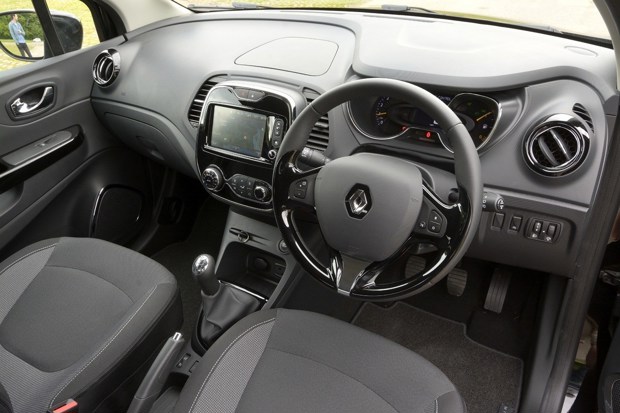
Date: 4 July 2014 | Current mileage: 4631 | Claimed economy: 76.4mpg | Actual economy: 52.2mpg
In my first update I talked about Renault’s decision to move from a small, Clio-based MPV to a small, Clio-based SUV. The key phrase here is ‘small, Clio-based’, because as you can probably guess, with the best will in the world, no MPV or SUV based on a Clio is going to be the last word in interior abundance.
So it falls to the designers to endow an ostensibly little car with that quality that makes its owner think of Dr. Who’s police box. Or any woman’s handbag: an unscientific capacity to contain stuff. And our Captur is indeed presently displaying the qualities of any woman’s handbag – it’s absolute chaos in there. I’m so embarrassed about the litany of litter that I’m not even prepared to take a picture of it.
This, of course, isn’t my fault. As a man, it’s in my genes to ensure that my house and my brain stay cluttered, but my car and my computer desktop stay entirely mess-free. The problem is, I have kids. Anyone with primary school aged children knows very well what their three main skills are: demanding food, talking constantly, and bringing rubbish home from school.
Pretend-SUV or otherwise, the Captur is a car aimed at young families and empty nesters – in other words, people with young children to consider, but either too cool or too old to think about a full-scale people carrier. Either way, a good amount of reasonably sized hiding places for the accoutrements of existence is essential. In this area, the Captur is lacking. And worse than that, quite often it seems that much of the cost cutting has been done in the realm of storage.
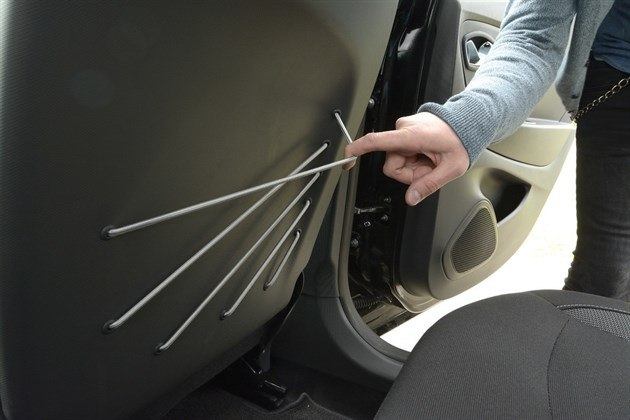
Nichol Jr is just several school trips from perfecting his Nirvana tribute band thanks to the Captur
For example, there’s no centre console storage box. Fair enough - lots of smaller cars don’t have a proper centre console. However, an option that Renault calls ‘storage between front seats’ (standard on everything bar base-level Expression models) is, in fact, a moulded plastic tray that slots precariously into one of the cup holders. Not only is it small and flimsy, if you’re over 6ft it acts as a spanner in the works, because with the driver’s seat lowered it jars against the seat angle adjuster, jamming it.
Then there’s the tiny glove box, which comes as standard already three-quarters full of car manual and circuit box. That’s not a problem unique to Renault, in fairness.
But my favourite storage solution is on the back of the chairs, where instead of seat pockets, Renault has placed thick strips of elastic of various lengths and at jaunty angles. So what we have is a contraption that’s less adept at securing books than it is at securing future record deals for my kids – my boy is five school runs away from perfecting Smells Like Teen Spirit on the seat back guitar that Renault has kindly gifted him with. The twanging is delightful, as you can imagine.
Those things aside, it’s good to note that the Renault does do the main thing properly: the boot is very well executed, which is to say that it’s big and square. It also has a double floor so that the base can sit flush with the lip – the holy grail of luggage compartment user-friendliness.
And even better, while it may fall short as a rubbish bin, the Captur excels in the not insignificant area of room for people – it’s a really spacious car, with a tall roof and proper rear legroom. And isn’t that what’s most important about these things? I could, after all, take my rubbish out of the car and throw it into a bin.
Driven mad, at exactly 50mph.
Mark's relationship with the Renault Captur is still defined by one thing: the multimedia system.
Date: 18 July 2014 | Current mileage: 5135 | Claimed economy: 76.4mpg | Actual economy: 52.1mpg
I know I keep banging on about it, but my relationship with the Captur is still defined by this one thing: the multimedia system. Whenever I’m asked about it, my answer is always the same: “It’s good, but the sat nav does my ‘ead right in.”
Take my last trip up to Newcastle, which is where I’m from but about 250 miles from where I live at the moment. Presently the M1 and A1(M) are enhanced by some gloriously lengthy stretches of necessary road enhancement. Mile-after-mile of skinny lanes, traffic cones, concrete boundaries, near-death experiences with inattentive lorry drivers, 15-minute overtaking maneouvres at 51mph, and despairing at people who still cannot grasp the concept of the average speed check zone. You know the type: screech to 49mph from 70-odd at every single camera.
Anyway, these places are stressful enough without my car’s INSISTENCE that it must remind me, every 30 seconds or so, that I’m driving through a temporary speed restriction zone. And the problem is, this warning cannot be switched off. It can be muted, by waiting until it’s happening then turning the volume dial down during that exact two-second window of opportunity, but it cannot be removed entirely.
That’s because, having turned down the volume, the system still momentarily drops the volume of whatever you’re listening to in order to facilitate the now nonexistent bong. It’s especially prevalent with an iPod connected, and it will do this for every last mile you’re driving through any speed-restricted zone. Every gap is like being poked in the side.

One of the few times the Captur isn't making a noise....
The only way it can be stopped is by switching the system off, and in the context of a 250-mile drive, a 20-mile silence is an unacceptable solution. Anyway, rant over. I’ll stop talking about this now. Please come back.
The “it’s good” part of “it’s good but the sat nav does my ‘ead in” is absolutely genuine. I like this car. I think Renault has, largely, done a good job with the Captur. The cabin might be too hollow and hard and monochrome for some tastes, but the flashes of gloss black – especially those in the steering wheel – are lovely and really lift it.
It’s also very good fun to drive – a victory for the collective over the sum of its parts. This is, after all, a small, heavy, front-wheel drive car that’s disproportionately tall and is powered by a 1.5-litre diesel engine. It should be no more suited to enjoyable driving than a pair of knee-high Dr. Marten’s are to doing a marathon. But it is. Its handling is predictable, its steering light but accurate, and its grip levels generally high – a couple of minor anomalies during wet weather aside. It has that ‘can be thrashed’ quality that the Clio (on which it’s based) always has, albeit with an obviously higher centre of gravity.
In conclusion then, the Captur is far, far more enjoyable when you’re looking out of the windscreen than into the touchscreen. And that’s all I have to say about that.
No maps found!
Our Captur has thrown its toys out of the pram and decided it doesn't want the navigation to work anymore.

Date: 1 August 2014 | Current mileage: 5135 | Claimed economy: 76.4mpg | Actual economy: 52.1mpg
I’m aware that I promised to stop talking about the Captur’s navigation system during my last update, but I think it’s been reading the nasty things I’ve said about it and decided to take its ball home. Here’s what I was welcomed with when I got into the car a couple of weeks ago: 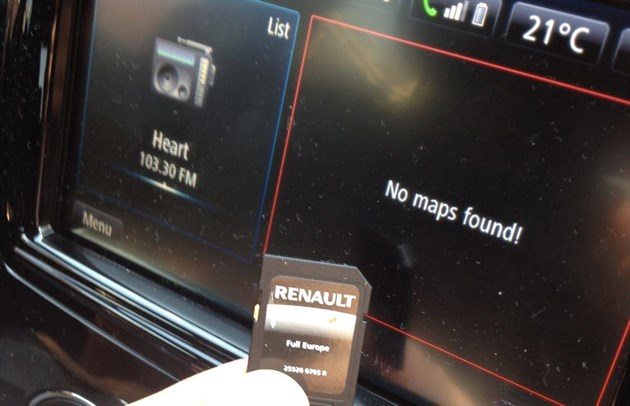
Someone had been listening to Heart FM in my car! Scandalous. Also, the SD card with the sat nav on it had apparently wiped itself. Or perhaps self destructed during an Olly Murs song. Either way, my £110 ‘European mapping’ has gone.
Inexplicable and annoying this was, but it did present an opportunity to contact a Renault dealership and see how this apparently small problem would be handled.
Because I know enough about car dealerships to know that things are rarely simple, I called first rather than drive straight down there. And, although the lady on the other end of the phone at Benfield Renault Newcastle was lovely, it sure enough doesn’t look like it’s going to be simple.
The call went thus: on explaining that my sat nav had stopped working, I was asked to look in the handbook because it could be a simple software update that’s needed. This, I was told, wouldn’t be covered under warranty and I’d be charged. Puzzled, I explained that the system did tell me it needed updating a few days ago, but this was after it spat its sat nav out and the two things seemed unrelated.
Some conversational toing and froing happened, all very pleasant, and I was soon informed that my car would need to be booked in. Alas, I’d have to wait until the end of August if I wanted one of the dealership’s nine courtesy cars (make of that backlog what you will). So I decided just to book it in and wait in the showroom while the Renault technicians do their thing.
This will take four hours, apparently. They better have a good Flavia machine and some back copies of Take A Break. And there was me thinking they’d just send me a new SD card. I’ll let you know how it goes. If nothing else, I will have some good stories to tell when I return, probably involving aliens and shock pregnancies. Possibly a combination of the two.
Renault maps found!
Mark's suspicions about a gammy SD card were correct. It had corrupted itself. And so he had to use something called a 'map'.
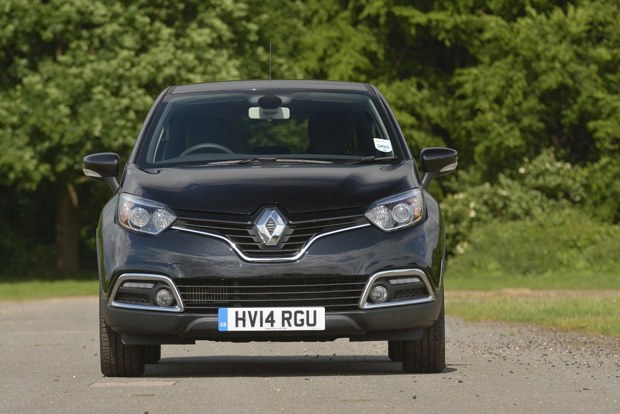
Date: 22 August 2014 | Current mileage: 6366 | Claimed economy: 76.4mpg | Actual economy: 50.5mpg
My suspicions about a gammy SD card were correct. It had corrupted itself. Technically not Renault’s fault, and in fairness to Benfield Renault, the service was first class – frothy coffee and everything, and the card was replaced by the following morning, into a lovely, cleaned car.
It transpires that the Captur is subject to a recall for a navigation update. I’d never heard of this before, so it’s clearly just a non-urgent bug update for the nav, which Renault will sort out as and when Captur models come in. That’s maybe something to get in touch with your local dealer about if you’ve got one, though.
It’s funny, as much as I’ve whined on and on (and on) about the nav, just not having it for that one journey to the dealership was a first-world nightmare. I’d failed to check the address of the place before going there, assuming the dealership would be in the same place as it was a few years back. It wasn’t, and because I’ve hit my data limit on my phone (long, boring story), I couldn’t Google Map it either.
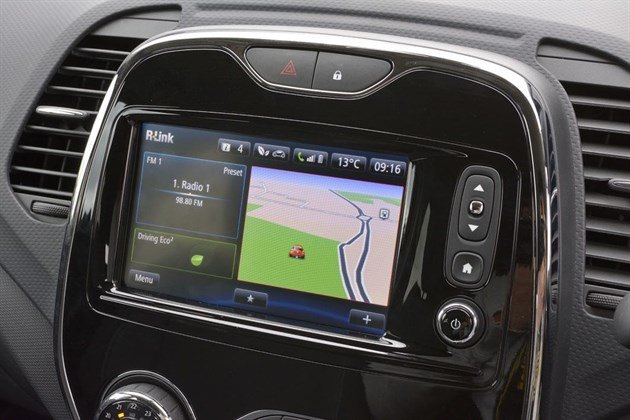
Some navigation working, yesterday
So I had to do that thing we all did in the ‘90s – call the place we’re going, look for a street sign, tell the person on the phone the street name, then ask for directions, none of which actually register as they’re being explained, but all the while me pretending that they are, then putting the phone down and continuing to aimlessly drive around, getting more and more annoyed at the place for not being somewhere better. Like next door to my house.
I found it eventually (after ringing home and asking my wife to be a talking map), but all of a sudden, the R-Link was my friend again. I missed it in the same way I miss my mental cat that I had to give to a shelter because it kept clawing chunks out of my arms.
But now it’s back, I’m not getting lost anymore, and I’ll definitely, definitely stop moaning about it now. And anyway, I’ve got nothing to complain about, really – people are suffering all kinds of actual hardships. There’s Katie, who’s discovered that "Pete’s not a nice person!" And Kerry, who’s at war with Brian! Again! And Kieren, who can’t be faithful to anyone! And Danielle, who’s definitely not Winston’s type! And Lindsay, who isn’t looking after her kids! And skinny Amanda, who’s worrying her pals! Then Miley, who went too far! And Little Mix, who are on the rocks! And Zachelle, which is a name I don’t understand!
Sorry, I knew I should have read Northern Golfer in the waiting area instead of Star! and New!
Eco sorrier
Mark is trying to improve the fuel economy of the Captur dCi engine. But without much success so far.
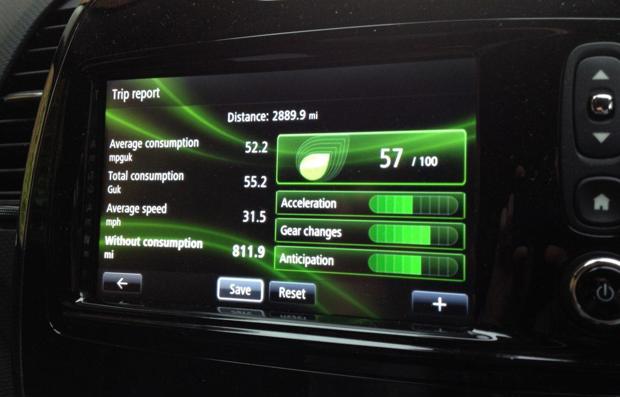
Date: 12 September 2014 | Current mileage: 6366 | Claimed economy: 76.4mpg | Actual economy: 52.2mpg
Because I’ve spent most of my time banging on about the Captur’s infotainment deficiencies, I’ve not really given proper consideration to the main issue that the majority of perspicacious small car buyers are concerned about: fuel economy. So let’s do that.
You’ll see from the details above that we’re falling dreadfully short of the car’s claimed average fuel economy number. All cars do – I believe the official mpg test requires a car to slide down a buttered hill in neutral, and not much else – but the Captur is a full 25-odd miles per gallon behind what Renault says it’s supposed to be doing.
The Captur’s tank is 45 litres, which is 9.9 gallons, so I’m getting roughly 500 miles from a tank. And that situation has never really changed since I took the car, always hovering between the 50mpg and the 52mpg mark no matter how I drive. I don’t think I’m that heavy footed and what’s more, I always seem to have the car moving on the green bar.
The what? Well, thanks for asking. The green bar is Renault’s easy-to-reference eco companion. It’s a two-inch illuminated horizontal bar of judgment beneath the rev counter that stays green if you’re driving in eco-friendly fashion, but goes through yellow, orange and red if you’re being evil.
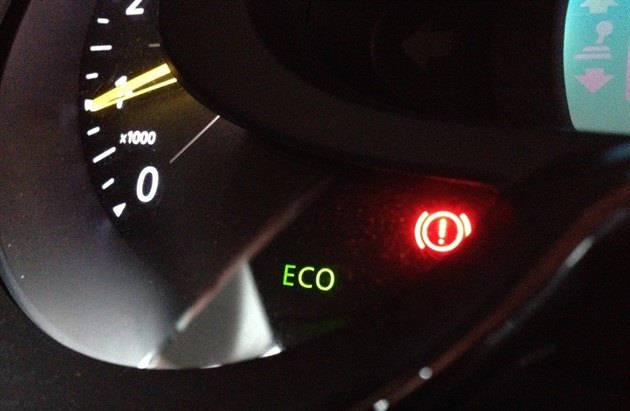
Eco Button. Making things slower since last week
To me it seems linked solely to accelerator movement, and given that it seems to be bright green most of the time I’m confused as to how my economy could be so low. For those who require yet more auto-flagellation, the Captur has a full eco driving judgment system, which Renault deems so important that by default there’s a shortcut to it on the navigation home screen.
Press the shortcut and it’s like stepping out in front of the Britain’s Got Talent panel, except instead of getting booed for being a below average singer or a person of questionable mental health, you’re booed for not shifting from second to third at exactly the right time. Harsh.
You’re then scored out of 100 for your eco driving capabilities. At the moment I’m stuck at 57, making me the equivalent of this gentleman. I tried resetting it and getting to 100 once, but I realised that I’d gone from my house to the Metro Centre without looking at the road once. Or so it seemed. But, as the great James Blunt once said, I won’t lose no sleep on that, ‘cause I’ve got a plan.
There’s a button on the centre console marked ‘ECO’. I’ve pressed it. All it seems to have done is made the throttle amazingly unresponsive and the car much, much slower, but if it gives me an extra few miles out of the tank I might be willing to live with that. I pressed the ECO button right after filling up recently, so I plan to get through the whole tank in ECO and see how many miles I get. Wildly unscientific, agreed, but I’ll let you know how it goes.
Progress is too leisurely
Mark is finding that overtaking National Express coaches in the Captur can be a long, drawn-out affair.
Date: 26 September 2014 | Current mileage: 7550 | Claimed economy: 76.4mpg | Actual economy: 56.8mpg
“With a mere 90 brake horsepower available, progress is too leisurely to be called fast, but on the motorway in fifth gear the Megane’s slow pace really becomes a pain. Uphill runs become power-sappingly mundane, while overtaking National Express coaches can become a long, drawn-out affair. Not my words – the words of Top Gear magazine.”
I’ve often got Alan Partridge quotes running through my head, but over the last few weeks the particular quote above has been ringing through it like an unwanted radio jingle. And not just because it’s about a 90 horsepower Renault.
Why then? Well it’s because recently I’ve been doing an experiment with the Captur’s Eco switch, which I mentioned in the last update. If you’re not inclined to look, the experiment was to determine whether pressing the ‘Eco’ button on the centre console would make the car any more economical, because I’ve been getting nowhere near the Captur’s claimed figure.
It’s taken me a few weeks to compress my way through a couple of tanks of diesel (one in Eco mode, followed by another in normal mode), but I can now report that the difference between the two is roughly 50 miles. I covered 510 miles with the Eco tank, whereas I’m regularly getting around the 460 mark.
That’s about a 10 per cent improvement – which funnily enough is the level of improvement that Renault claims the Eco switch should bring. In real terms, Eco mode gave me 511 miles from 41 litres of fuel, which is nine gallons, meaning 56.8mpg.
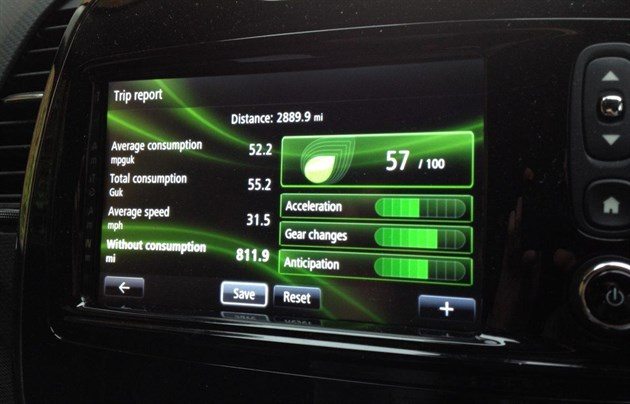
Now, clearly over the course of a year (or any length of time), that’s going to make a difference – it makes every tenth tank free, if you like – but I did spend most of the time while the Captur was in Eco mode wondering whether it was worth the bother.
The Eco button remaps the throttle and reduces engine power, which often means working the car harder – when doing uphill runs or overtaking National Express coaches, for example. Reducing an engine’s power to save fuel is arguably like saying you’re going to save energy by only using one leg.
And while that analogy is true in terms of the altogether more strenuous operating experience of the Captur after hitting the Eco button, the system did actually do its job and save fuel, which is to Renault’s credit. And that’s despite my dreadful gear changing, acceleration and anticipation skills, as you can see from the picture above. (Judge Renault is a constant encouragement.)
So it’s down to you to make a choice, really - fuel or fun? I chose to depress the Eco button after that one tank and have no intention of touching it again. And (dramatic epiphany alert) that made me realise something. I genuinely enjoy the Captur’s driving experience. It’s a really well set-up, good fun car. It’s a slightly strange fact, that, because as a family-oriented small MPV it doesn’t need to be good to drive, in the hot hatch sense of good that I mean here. But it is.
Regaining the engine’s full thrust (such as it is) and the throttle’s full sensitivity made the whole thing fun again. So if you’re to take anything from this experiment, it’s that more thrust and more sensitivity equals more fun. Thumbs up.
Deep heat
After almost six months with the Captur things were going so well. But then a switch broke, creating a build quality storm in a teacup.
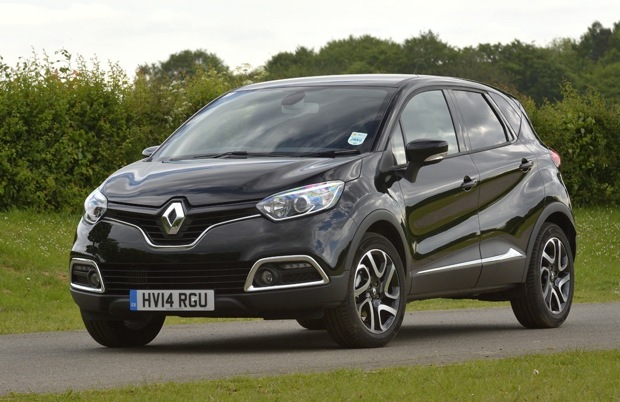
Date: 10 October 2014 | Current mileage: 7900 | Claimed economy: 76.4mpg | Actual economy: 55.1mpg
I’ve been driving this French crossover around for about six months now and I’ve not yet initiated a detailed discussion about build quality. That’s partly because to do so would be a big fat cliché, like signing off an Alfa Romeo review with a reference to being "stranded at the side of the road," but also because the Captur’s build quality is okay. It’s more or less on par with all the other small SUVs out there.
So it’s with a bit of sadness that I must report a build quality storm in the teacup of my custody of the car: I’ve got a broken switch. Probably the worst thing – no, definitely the worst thing – about the Captur is the baffling layout of some of the controls.
The steering wheel, for instance, has four buttons, all of which seem to be linked to the cruise control in some way, but it’s not clear how. It would be nice to have, oh I don’t know, volume controls for the stereo there – you know, something that gets regular use. Even putting the Eco button there would be an improvement, but that’s down near the handbrake. Of course.
About one month ago, my wife came home from work slightly giddy and asked me whether I knew the Captur has heated seats. This was brilliant news for her, because, like a lot of women I know, she’s cold all the time, even when our thermostat is set to ‘midday in Malibu’.
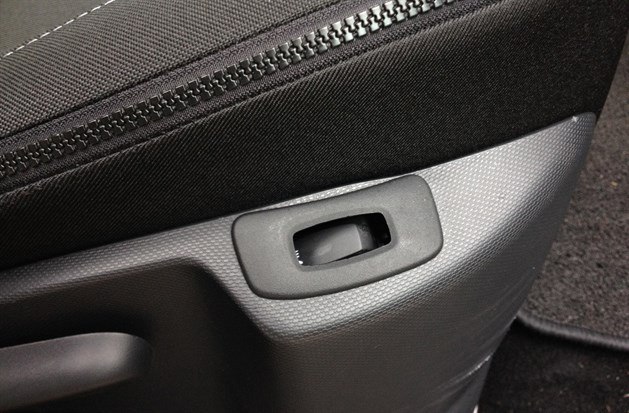
And things were going so well...
Obviously the answer was yes, I did know this. However, I only knew this because I’d read the equipment sheet that came with the car and actively searched for the heated seat controls as a result. She hadn’t read the info, obviously, so it took her five months to find the switch. It’s on the seat base, hidden between the seat cushion and the door card.
Ironically there’s more logic to this than any of the other switchgear – the heated seat switch is actually on the seat – but it’s also out of sight, only found after a bit of blind fumbling.
And it was while fumbling around for it a couple of days ago, on a cold dark night, that I apparently pressed it a little too hard, so the whole thing sank down into the plastic seat base. And to add to the fun, this happened after I’d switched it on, so now I can’t switch it off.
So, while the Captur is now literally giving me a warm, fuzzy feeling every time I drive it, I’m resultantly forced to talk about French build quality when I really didn’t want to. So close to the end of my time with it, too.
I am (sort of) your father
Mark has been driving several other small crossovers - like the Nissan Juke - and comparing them to the Captur.
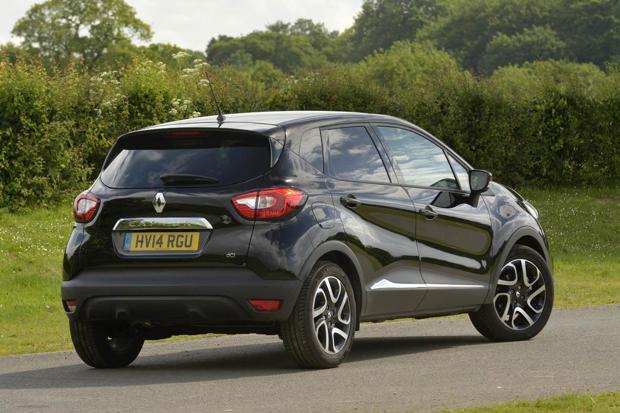
Date: 24 October 2014 | Current mileage: 8150 | Claimed economy: 76.4mpg | Actual economy: 54.0mpg
Another month, another compact crossover launched. This time it was Fiat’s turn and having just returned from an extended coach trip to Italy that also included driving the new 500X a bit, I can tell you that the compact crossover niche is much better for it.
By taking the instantly recognisable and desirable DNA of the 500 and making it both more practical and on-trend, Fiat has basically crafted an Urban Outfitters bag for life on wheels. It’s the carry all accessory that every hipster mum or dad will want.
It’s also the latest thing to come and have a go at the segment’s progenitor, the Nissan Juke. There were, of course, small 4x4-type cars long before the four-year-old Juke – the Suzuki Vitara is ancient, and the Fiat Sedici pretty much did the same thing back in 2005 – but there’s no doubt that the Juke started the hatchback-based crossover thing that the 500X is the latest version of.
The Captur is, of course, part of this set. The reason we’re discussing the 500X is because the most striking thing about it is that, in my uneducated opinion, it’s the only small crossover that can match the Juke when it comes to that most elusive and very subjective quality: personality. The Captur doesn’t come close. And this should worry Renault.


All about the character. Fiat 500X and the Nissan Juke.
A couple of weeks ago, before driving the 500X, I spent a week with a Juke so that I could compare it to my Captur. I drew two conclusions. Firstly, the Captur is better to drive, vastly more comfortable and significantly more spacious. And secondly, the Juke is a million times more interesting.
Unfortunately (for Renault), it’s point two that sells more cars, which is why last year Nissan sent nearly 38,000 people merrily on their way out of a showroom in a Juke, each blissfully nonplussed about their car’s poor ride quality, questionable ergonomics, limited visibility and cramped rear space.
In plenty of ways the Captur is a really, really good car. It’s packaged well, so it has enough cabin room and boot space for a family of four to be comfortable. It drives like the Clio, which is to say it balances a sense of dynamism with overall ride comfort. And it looks decent, especially in a bright colour – every time I pass an orange or blue one I remember how much the black paint dulls the Captur.
But it’s terminally ordinary and in a flourishing market whose starting point (the Juke) traded on striking visual impact, plus with newcomers like the 500X following suit, I wish Renault had pushed the boat out a bit more. So, next week I’ll be talking to someone on the Captur’s design team, and it’s a point I’ll try to push. I’ll let you know how it goes.
The Renault Modus was 'somewhat unattractive'
Mark gets an exclusive chat with Anthony Lo, Vice President of Exterior Design for Renault. And gets some interesting insights.
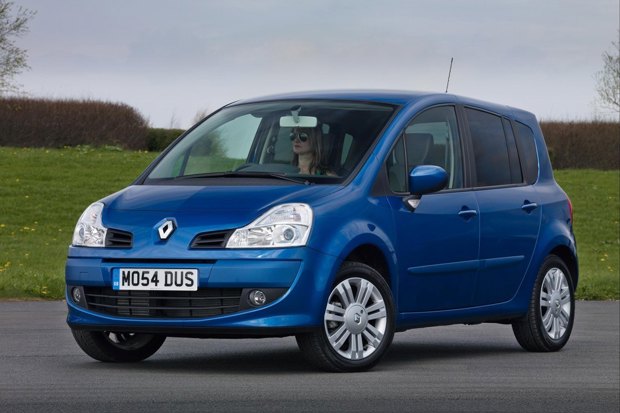
Date: 7 November 2014 | Current mileage: 8350 | Claimed economy: 76.4mpg | Actual economy: 54.2mpg
Someone I spoke to last week called the Renault Modus "somewhat unattractive". A ten per cent interest rate for a personal loan is somewhat unattractive. A Renault Modus is more along the Wonga lines, I’d suggest.
But this was a statement shrouded in diplomacy, because the person who said it was Anthony Lo, Vice President Exterior Design, Renault, pictured above.
I mentioned in my last update that I’d be speaking to someone from Renault’s design team about the theory behind the Captur because, for me, while the car is probably the most practical of the compact crossover bunch, it’s perhaps the least visually arresting. Notwithstanding beauty being in the beholder’s eye and all that.
In relatively lengthy conversation there were some real highlights. So here are six out-of-context quotes, all verbatim but chosen to eek as much controversy as possible from a fairly placid, if insightful, interview:
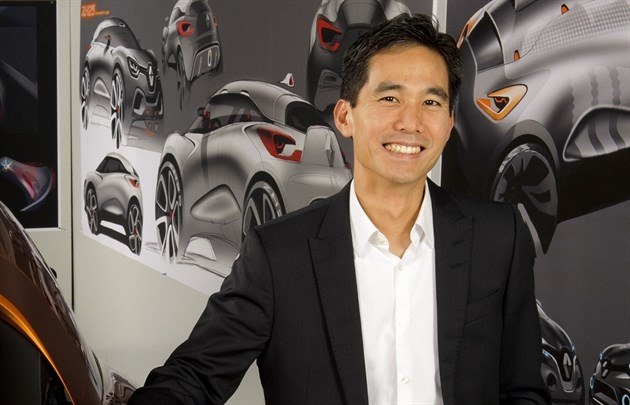
Anthony Lo, Vice President Exterior Design, Renault
On the Captur’s predecessor, the Modus:
"The car is somewhat narrow, with a high roof and a quite tall body, which makes it a bit unstable. I think this explains a little bit why the Modus was not that successful in the marketplace, even though actually this fits more or less with what its customers are looking for."
On Renault’s ‘stages of life’ design philosophy:
"You begin by falling in love, then you explore the world (which is where the Captur fits – a car to explore), then you start a family, then you work, play, then you acquire wisdom. Not necessarily in that particular order, but it shows that we are a human brand."
On the challenges of designing a small crossover:
"With a crossover, which is a new segment and a new entry in the B-segment for Renault, there are not a lot of references available – there’s the Juke and some other products that are perhaps not as successful."
On the Captur itself:
"We made the cabin look as long as possible, [with] a cab-forward location for the windshield, so from the side view this car [looks] really quite roomy and that was the design intention from the beginning."
On the segment leading Nissan Juke:
"I think the juke is not the most efficient. It has a very impactful design and it’s doing very well in the market for that reason, but we want to differentiate ourselves. We went a car not just for the front row [of seats]."
On Renault’s last crossover, the Koleos:
"I think the car is over-bodied but the wheels and track are not wide enough to hide the mass, the bulk. The Koleos isn’t the only car on the road that suffers from this proportional issue."
This morning I lost another HGV
Mark's time with the Captur is up. Here's the end-of-term report, including the strange disappearance of a heavy goods vehicle.

Date: 21 November 2014 | Current mileage: 8600 | Claimed economy: 76.4mpg | Actual economy: 54.4mpg
I’m a member of a small club. We hang around school playgrounds every morning looking uncomfortable, and we have a very specific facial expression. It says "ten years ago I thought I’d grow up to be a more powerful and important and interesting man than this."
But one reason I like being in the Drop-off Dads Club is that every day, just after the mind fog of another argument about who put whose book bag where, and why it’s not acceptable to wear slippers to school, and why some trees are taller than unicorns but others stay green for the whole year has cleared, I get to do proper, real-world road testing.
Embarrassing, I know. But that’s how the Captur has mostly been used over the last six-or-so months, as the school run tour bus. It’s a measure of how successful the car has been that I’ve not had one single complaint from the kids about it in that time. Not one. The Captur has been good family trainsport, which for a small crossover is quite remarkable, and a testament to the design team at Renault who, as I discovered recently, paid much attention to the Captur’s interior packaging. I expect a Juke would have been much harder work, as would have, say, a Clio.
It’s not been without irritations, though, and they’re all of the sort that a regular first drive wouldn’t necessarily highlight. It's the little things, things that probably aren’t worth bringing up in a professional (and I use that term very loosely, in my case) road test. Things like the fact that the radio doesn’t switch off until a couple of seconds after you’ve turned the engine off and opened the door. So your neighbours will also hear about the poor man who hasn’t been able to clear up the “gruesome lesions near his…”

The result of real world testing...
And there’s the card key, which is supposed to be like a credit card but is actually just a massive, awkwardly shaped object to hang your other keys from. And the auto-locking mechanism, which in attempting to be convenient actually becomes like a man who holds a door open for you then stands in the doorway; it will often lock the car as you’re walking around it to retrieve something from the passenger side, when you want it to stay unlocked.
The hidden stalk for the radio controls I can live with, but I still don’t understand quite what the buttons on the steering wheel do, nor why the cruise control switch is near the handbrake. And as it’s got colder I’ve also noticed that the air conditioning takes ages to warm up. And the turning circle is dreadful.
And finally, leading eventually into the headline you see above, you can lose an entire HGV in the rear three-quarter blind spot, I've recently learned. If you happen to park on a right hand side kerb, on the wrong side of the road (as I have to outside my kids' school), then looking over your left shoulder to re-join the traffic means being faced with the inside of a massive C-pillar, big enough to swallow a heavy goods vehicle. I call it the DD-pillar.
But, you know, in seven months I’ve managed to avoid hitting one, so no harm done. And other than those gripes, I’ve genuinely enjoyed the Captur, and would recommend one to the sort of family-with-young-children audience it’s aimed at. Not in black, though. Makes it look like a London taxi. One that would keep getting stuck outside the doorway of the Savoy Hotel.
